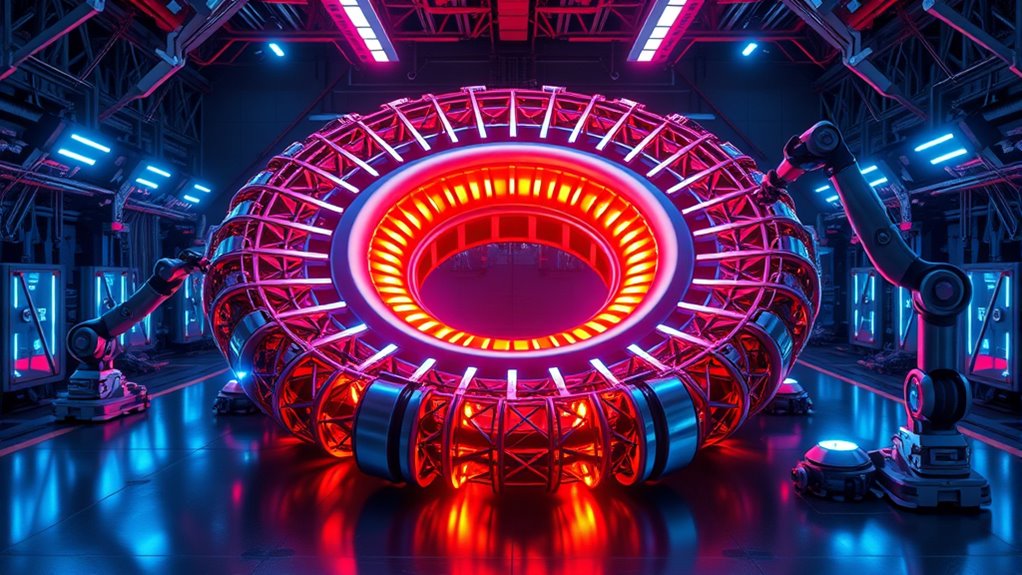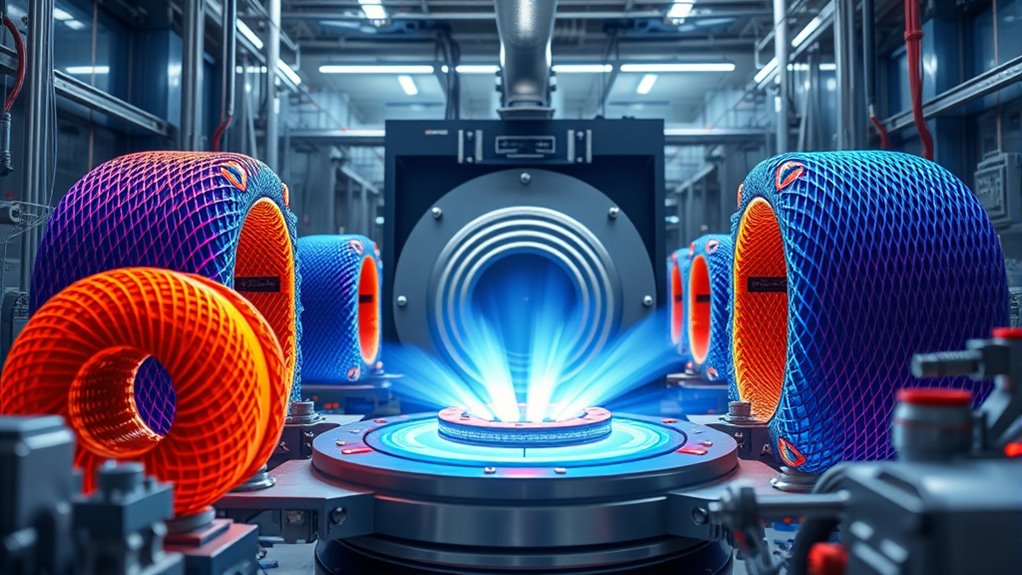Advancements in 3D printing are transforming how fusion reactor magnets are made, enabling you to create complex shapes and internal structures impossible with traditional methods. This technology allows for stronger, more durable magnets that can withstand extreme heat, radiation, and magnetic stresses. Precise printing guarantees reliability and safety, while new materials improve performance. If you want to explore how these innovations are shaping the future of fusion energy, there’s much more to discover ahead.
Key Takeaways
- 3D printing enables complex, optimized magnet designs critical for efficient and compact fusion reactor containment fields.
- Advances in materials science improve magnet durability to withstand extreme heat, radiation, and magnetic stresses in fusion environments.
- Precise additive manufacturing ensures flaw-free magnets, enhancing performance reliability and reactor safety.
- Embedded cooling channels and sensors in 3D-printed magnets improve heat management and real-time monitoring.
- Ongoing technological innovations accelerate the development and deployment of sustainable, commercially viable fusion reactors.

Advancements in 3D printing are transforming the way we design and build fusion reactors, especially when it comes to magnets. These powerful components are essential for confining hot plasma and sustaining fusion reactions, so improving their manufacturing process can markedly accelerate reactor development. With 3D printing, you can produce complex geometries that traditional methods struggle to achieve, opening new possibilities for optimizing magnetic fields. One of the critical factors in this process is magnet durability—your magnets must withstand extreme conditions, including intense heat, radiation, and magnetic stress. 3D printing allows you to select specialized materials and design structures that enhance resilience, making magnets more durable over time. However, ensuring this durability depends heavily on printing precision, which is essential to create magnets free of flaws, voids, or weak points that could compromise their strength or performance. Precise printing techniques enable you to build magnets with intricate internal architectures, such as lattice structures or reinforced layers, which improve overall stability and longevity. Moreover, the ongoing progress in 3D printing technology means you can incorporate embedded cooling channels or integrated sensors within the magnets, which are essential for managing heat and monitoring performance during operation. These innovations not only improve magnet durability but also contribute to the overall efficiency and safety of fusion reactors. As you push toward commercial viability, the combination of enhanced printing precision and material advancements will be key to producing high-performance magnets that can withstand the rigors of sustained fusion reactions. Additionally, material science plays a crucial role in developing new alloys and composites that are better suited for extreme environments, further advancing the potential of 3D-printed magnets.
Frequently Asked Questions
How Durable Are 3d-Printed Magnets Under Extreme Fusion Conditions?
You might wonder about the durability of 3D-printed magnets under extreme fusion conditions. Their magnet longevity depends on material resilience, which can vary based on the printing process and materials used. While innovations aim to improve their resistance to high temperatures and radiation, current magnets may face challenges like degradation over time. Ongoing research seeks to enhance their durability, ensuring they withstand the intense environment inside fusion reactors.
What Materials Are Used for 3d-Printing the Magnets?
You explore material innovation and manufacturing techniques when considering what materials are used for 3D-printing magnets. Typically, engineers use rare-earth metals like neodymium or samarium-cobalt, mixed with polymers or resins for printing. Advances in additive manufacturing allow the integration of magnetic particles into durable matrices, enabling precise shapes and complex structures. These innovations improve the magnets’ performance under extreme conditions, essential for applications like fusion reactors.
How Cost-Effective Is 3D Printing for Large-Scale Magnet Production?
You’ll find that 3D printing offers significant cost savings for large-scale magnet production by reducing material waste and minimizing labor costs. Its manufacturing scalability allows you to quickly produce complex designs and adapt to demand changes without hefty retooling expenses. While initial investments can be high, the overall cost-effectiveness improves as you scale up, making 3D printing a promising approach for cost-efficient, large-scale magnet manufacturing.
Can 3d-Printed Magnets Be Easily Repaired or Replaced?
When considering whether 3D-printed magnets can be easily repaired or replaced, you face both benefits and challenges. Their magnet longevity depends on material quality and usage conditions, making repairs sometimes complex. Repair challenges arise because 3D-printed magnets often require specialized techniques, and replacing them may involve intricate procedures. While they can be designed for easier upgrades, you should expect some limitations in repair simplicity, emphasizing the importance of durable, high-quality production.
What Are the Environmental Impacts of Using 3d-Printed Magnets?
You might wonder about the environmental impacts of using 3D-printed magnets. While they can reduce waste with precise manufacturing, recycling challenges arise because specialized materials are often used, making reuse difficult. Material sustainability depends on choosing eco-friendly, recyclable materials, but current limitations hinder large-scale sustainability efforts. Overall, adopting 3D-printed magnets requires careful consideration of recycling challenges and the pursuit of more sustainable materials to minimize environmental footprints.
Conclusion
As you witness this groundbreaking race, it’s clear 3D-printed magnets could revolutionize fusion energy faster than anyone imagined. You’re on the edge of a scientific revolution that might solve the world’s energy crisis—turning what once seemed impossible into reality. Keep your eyes open, because this innovation could change everything, making clean, limitless power accessible in ways you never thought possible. The future of energy is unfolding right before your eyes—and it’s more exciting than any sci-fi story.










